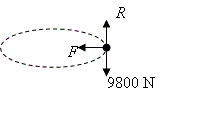Solution 20.3
From Mechanics
(Difference between revisions)
(New page: We start by converting the speed to SI units. <math>60\text{ km/h }=\frac{60\times 1000}{60\times 60}=\frac{50}{3}=\text{16}\textrm{.}\text{7 m}{{\text{s}}^{\text{-1}}}</math> The diagra...) |
|||
| Line 14: | Line 14: | ||
& F\le \mu R \\ | & F\le \mu R \\ | ||
& 5556\le \mu \times 9800 \\ | & 5556\le \mu \times 9800 \\ | ||
| + | & \\ | ||
& \mu \ge \frac{5556}{9800} \\ | & \mu \ge \frac{5556}{9800} \\ | ||
| - | & \mu \ge 0.567 \\ | + | & \mu \ge 0\textrm{.}567 \\ |
\end{align}</math> | \end{align}</math> | ||
Current revision
We start by converting the speed to SI units.
\displaystyle 60\text{ km/h }=\frac{60\times 1000}{60\times 60}=\frac{50}{3}=\text{16}\textrm{.}\text{7 m}{{\text{s}}^{\text{-1}}}
The diagram shows the forces on the car.
\displaystyle F=m\frac{{{v}^{2}}}{r}=1000\times \frac{{{\left( \frac{50}{3} \right)}^{2}}}{50}=5556\text{ N}
\displaystyle R=mg=9800
\displaystyle \begin{align} & F\le \mu R \\ & 5556\le \mu \times 9800 \\ & \\ & \mu \ge \frac{5556}{9800} \\ & \mu \ge 0\textrm{.}567 \\ \end{align}

